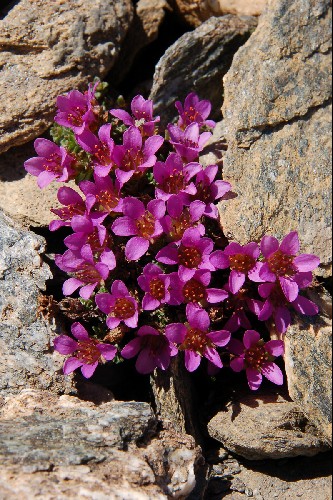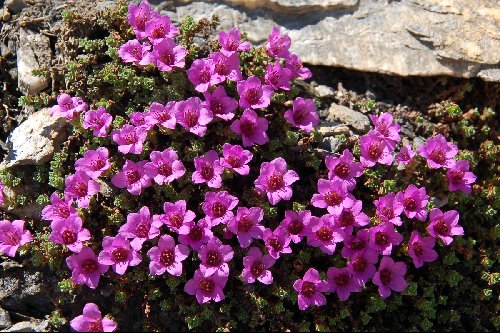Authors: L.
This polymorphic species varies greatly over its vast range. It forms a loose mat of leafy stems or sometimes a more or less compact cushion. Leaves 2-6mm long, opposite, obovate, dull dark green with one to five small lime glands. Flowering stems very short, leafy, glandular-pubescent and one flowered. Petals 5-15mm long, pale pink to deep purple, rarely white. Circumpolar regions and mountains to the south, including Great Britain. On moist rocks, screes, gravel banks, etc., on both igneous and calcareous rocks. Hybrids with S. biflora have frequently been found in the wild and brought into cultivation. As might be expected of such a wide-ranging plant, it shows considerable variation in different parts of its range, amongst which the following have been described by botanists: S.o. subsp. rudolphiana; very compact and small in all its parts, flowers rose-purple, granite formations in the eastern Alps. Subsp. blepharophylla; leaves with very obtuse apex and long cilia on the apical half, purple flowers starry and not as ornamental. Normally on granite, central Alps, particularly in Austria. Subsp. murithiana; leaves with only one lime gland, the calyx bearing gland-tipped cilia. Normally on granite in the western Alps, Pyrenees and Sierra Nevada. Subsp. latina; leaves with three lime glands, flowers clear rose-pink, large. On calcareous formations in the Apennines. A strong grower in the gardens. Subsp. speciosa (syn. subsp. apennina); Flowers large, often with six petals. Fairly compact cushions, apical part of the leaf has a broad, cartiligenous margin. Central Italy in the Abruzzi mountains. Subsp. asiatica; very large flowers. Leaf tips finely toothed. Mountains of Siberia and the Himalaya. Subsp. paradoxa; leaves alternate. Central Pyrenees. Other forms have been differentiated, but from the horticultural point of view the selection of cultivars is more important, though with such variability in the wild it would be possible, by searching around, to select an almost infinite number of variants: 'Alba'; clear white form with rather thin, starry flowers but very floriferous when well suited. Leaves small. Not as strong growing as some cultivars. 'Splendens'; a fine form for general garden purposes with large, well rounded flowers of a rich rose-purple. Vigorous and partial to calcareous soils. Said to have originated in the Pyrenees. 'W. A. Clarke'; an extra fine colour form with rich crimson flowers and a neat habit. Not as strong growing as 'Splendens'. 'Wetterhorn'; large rose-red flowers. A good grower. 'Ruth Draper'; a particularly large flowered form. 'Theoden'. Large rose-purple flowers. Derived from material found on Ingleborough. 'Coccinea'; compact habit with small red flowers. 'Florissa'; smaller leaves and lilac flowers. 'Latina'; leaves with more prominent silvery-white glands. Flowers deep pink. 'Skye Form'; smaller leaves and bright magenta flowers. 'Vaccariana'; deep red-purple early flowers. This species is a good garden plant but must have a moist, cool soil, preferably of a rather gritty nature and not in full sun. A north-facing slope often provides the best position. In the wild hybrids can sometimes be found with S. biflora. These are more vigorous than S. biflora (S. X kochii), with clawed, widely spaced petals of strong lilac showing the reddish calyx beneath. In Greenland S. oppositifolia also hybridises with S. aizoides. See under S. X nathorstii. [Pl.448].
Plant Portrait: Saxifraga oppositifolia


Sign up for our newsletter to receive our monthly update direct to your inbox. Featuring our latest articles and news.
Built by Atomic Smash

